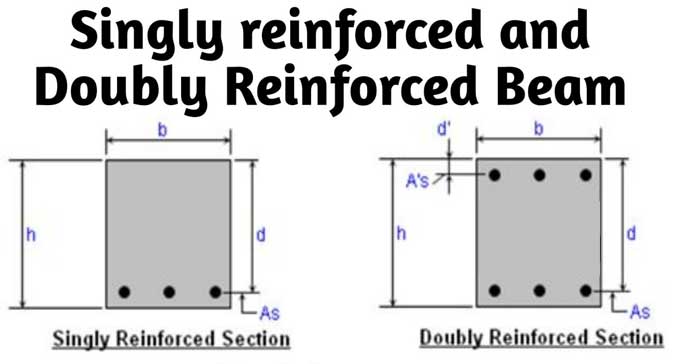
How are Singly Reinforced Beams and Doubly Reinforced Beams different?

The longitudinal reinforcement in the tension zone of a singly beam determines its strength. Concrete sections in beams handle compression forces. Distinguished from single reinforced beams, double reinforced beams consist of steel reinforced in both the tension and compression zones. When headroom considerations or architectural considerations limit the depth of the beam, this type of beam will be essential.
Importance of Compression Reinforcement in Beam
1. A concrete beam should be strengthened to make it more durable.
2. The moment loading should be minimal.
3. Stirrups are placed during concrete placement and vibrations to keep them in place.
4. Member deflections should be reduced over the long term.
5. Flexural calculations ignore the presence of compression reinforcement added for purposes other than strength.
Define Singly Reinforcement Beam
For singly reinforced beam sections, reinforcements are provided to oppose tensile stresses due to shear and bending. In practice, singly reinforced beams are provided with two additional bars in the compression face of the beam to facilitate tying stirrups to the bars. The nominal diameter of these reinforcing rods is either 8 mm or 10 mm.
Define Doubly Reinforcement Beam
It is designed as a double reinforced concrete beam when the depth of the section is restricted because of architectural reasons or basement floors. The bars are reinforced on the compression face so that they can withstand compression stresses. To counteract bending and shear stresses developed due to torsion, beams are reinforced longitudinally.
Design of Singly Reinforcement Beam
During tension, a beam is known as a singly reinforced beam because it is longitudinally reinforced only in the tension zone. Concrete concedes the compression in beams such as these when the reinforcement carries the decisive bending moment and tension.
The tension zone cannot be reinforced only, as the stirrups need to be tied to it as well. Consequently, two rebars are used in this area to fasten the stirrups, and these rebars serve as false members only for the stirrup holders.
Design of Doubly Reinforcement Beam
The doubly reinforced concrete beam design may be required when an architectural or other constraint limits the beam's cross section. As a result, the concrete is unable to generate the required compression force to resist the given bending moment. To improve the beam's compression strength, steel bars are added to its compression zone.
Thus, a doubly reinforced concrete beam is a beam reinforced with tension and compression steels. Doubly reinforced concrete beams display a greater moment of resistance than singly reinforced concrete beams, regardless of cross section, slab size, or steel grade.
Difference between Singly & Doubly Reinforcement Beam
1. In the tension and compression zones of a beam, reinforcement steel bar is necessary.
2. Singly reinforcement beam refers to reinforcement in a beam that is only in the stress zone.
3. Doubly reinforced beams are those with reinforcement within the tension and compression zones.
4. The tension and compression zones will both contain a rod. Stirrups are necessary for the formation of beam structures.
5. It is necessary to place two reinforcements individually in the compression zone of the reinforced beam in order to maintain the stirrups in a standing position.
6. Although these two never carry loads, and it is only fiction, they never carry physical loads either.
7. Lower sections of beams are referred to as the stress zone, while upper sections are called compression zones.
RCC Beams
Reinforced concrete beams are built in cement concrete and reinforced with reinforcing bars. Beams add stiffness to structures by resisting tensile and compression forces.
It is common to use beams to handle vertical gravitational forces, but they can also be used to handle horizontal loads. In addition to carrying loads, the beam can transfer force to walls, columns, or girders, which will then carry the force to adjacent members of the structure. A beam rests on the joists in light-frame construction.
To learn more, watch the following video tutorial.
Video Source: Engineer's Coach
Compression Reinforcement Application
Due to the use of the strength method of design, compression reinforcement has decreased considerably because it fully reflects the strength potential of concrete in the compression zone. Nevertheless, compression reinforcement can be used for reasons other than strength, including lessening beam deflection over time, accounting for minimum moment load, and holding stirrups in place.


